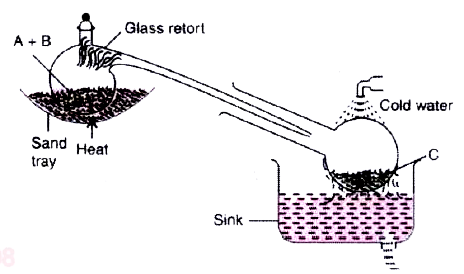All glass apparatus is used in the laboratory preparation of nitric acid. Explain ?
Step-by-Step Solution:
1. Understanding the Nature of Nitric Acid (HNO3):
- Nitric acid is a strong acid and is known for its highly corrosive properties. It can react with various materials, causing damage or degradation.
2. Corrosive Properties of Nitric Acid:
- The vapors of nitric acid are particularly corrosive. This means that when nitric acid is present in vapor form, it can attack and degrade materials that are not resistant to its corrosive nature.
3. Materials Used in Laboratory Apparatus:
- In laboratories, various materials are used to make apparatus, including glass, rubber, plastic, and metals. However, not all materials are suitable for use with nitric acid.
4. Why Glass is Preferred:
- Glass is made primarily from silicon dioxide (SiO2), which is chemically inert and has very low reactivity with nitric acid. This makes glass an ideal choice for containing and handling nitric acid and its vapors.
5. Consequences of Using Other Materials:
- If rubber, plastic, or metal apparatus were used, they would react with the nitric acid vapors. For example, rubber can be oxidized by nitric acid, leading to degradation and potential failure of the apparatus. Similarly, certain metals may corrode or react with nitric acid, compromising the integrity of the setup.
6. Conclusion:
- Therefore, all glass apparatus is used in the laboratory preparation of nitric acid to ensure safety and prevent any unwanted reactions that could occur with other materials.
---
- Nitric acid is a strong acid and is known for its highly corrosive properties. It can react with various materials, causing damage or degradation.
- The vapors of nitric acid are particularly corrosive. This means that when nitric acid is present in vapor form, it can attack and degrade materials that are not resistant to its corrosive nature.
- In laboratories, various materials are used to make apparatus, including glass, rubber, plastic, and metals. However, not all materials are suitable for use with nitric acid.
- Glass is made primarily from silicon dioxide (SiO2), which is chemically inert and has very low reactivity with nitric acid. This makes glass an ideal choice for containing and handling nitric acid and its vapors.
- If rubber, plastic, or metal apparatus were used, they would react with the nitric acid vapors. For example, rubber can be oxidized by nitric acid, leading to degradation and potential failure of the apparatus. Similarly, certain metals may corrode or react with nitric acid, compromising the integrity of the setup.
- Therefore, all glass apparatus is used in the laboratory preparation of nitric acid to ensure safety and prevent any unwanted reactions that could occur with other materials.
Topper's Solved these Questions
- STUDY OF COMPOUNDS OF NITROGEN - NITRIC ACIDBOOK - ICSECHAPTER - STUDY OF COMPOUNDS OF NITROGEN - NITRIC ACIDEXERCISE - ADDITIONAL QUESTIONS FOR PRACTICE
20 Videos
- STUDY OF COMPOUNDS OF CHLORINE - HYDROGEN CHLORIDE BOOK - ICSECHAPTER - STUDY OF COMPOUNDS OF CHLORINE - HYDROGEN CHLORIDE EXERCISE - QUESTIONS FROM PREVIOUS ICSE BOARD PAPERS
74 Videos
- STUDY OF COMPOUNDS OF NITROGEN- AMMONIA BOOK - ICSECHAPTER - STUDY OF COMPOUNDS OF NITROGEN- AMMONIA EXERCISE - Questions from Preivous ICSE Board Papers
77 Videos
Similar Questions
Explain the following :
All glass apparatus is used in the laboratory preparation of nitric acid .
View SolutionWhat is the special feature of the apparatus that is used in the laboratory preparation of nitric acid?
View SolutionThe figure given below illustrates the apparatus used in the laboratory preparation of nitric acid.
Write an equation to show how nitric acid undergoes decomposition.

View SolutionThe figure given below illustrates the apparatus used in the laboratory preparation of nitric acid.

Complete the following:
_____ is oxidised by nitric acid.
View SolutionThe figure given alongside illustrates the apparatus used in the laboratory preparation B of nitric acid.

Write the equation for the reaction in which copper is oxidized by concentrated nitric acid.
View SolutionThe figure given below illustrates the apparatus used in the laboratory preparation of nitric acid.
Write the equation for the reaction in which copper is oxidised by concentrated nitric acid.

View SolutionThe figure given alongside illustrates the apparatus used in the laboratory preparation B of nitric acid.

Name A (a liquid), B (a solid) and C (a liquid) (Do not give the formulae)
View SolutionThe figure given below illustrates the apparatus used in the laboratory preparation of nitric acid.
Name A (a liquid), B(a solid) and C(liquid). (Do not give the formulae)

View SolutionWhy all glass apparatus is used for preparation of nitric acid?
View SolutionExplain why only all glass apparatus should be used for the preparation of nitric acid by heating concentrated sulphuric acid and potassium nitrate.
View Solution
